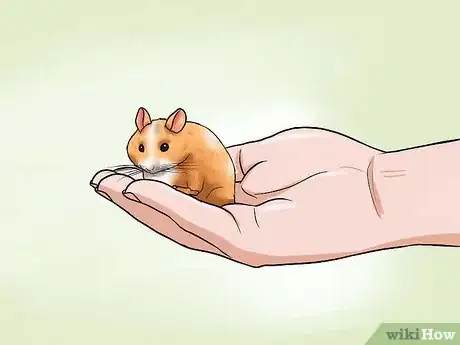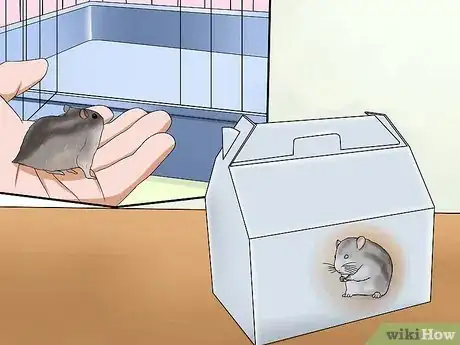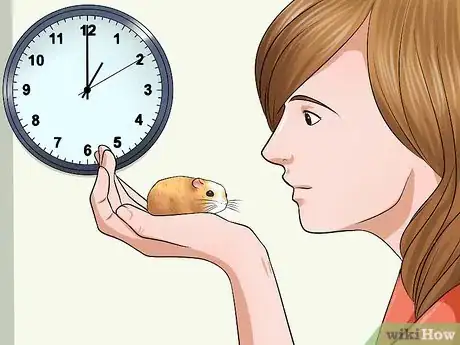This article was co-authored by Pippa Elliott, MRCVS. Dr. Elliott, BVMS, MRCVS is a veterinarian with over 30 years of experience in veterinary surgery and companion animal practice. She graduated from the University of Glasgow in 1987 with a degree in veterinary medicine and surgery. She has worked at the same animal clinic in her hometown for over 20 years.
wikiHow marks an article as reader-approved once it receives enough positive feedback. This article received 13 testimonials and 85% of readers who voted found it helpful, earning it our reader-approved status.
This article has been viewed 259,851 times.
Hamsters were introduced as pets in the late 1940s. [1] Originally from Syria, Hamsters became popular because of their easy maintenance, odorless living, and disease resistance. They are cute, cuddly, and small. They can make ideal pets for apartment living and for children. If you would like to bring a hamster into your home, there are a few things you should consider when picking out your new furry friend.
Steps
Choosing the Right Breed, Type, and Gender
-
1Research a breed that will fit into your lifestyle. Just like other pets, hamsters have different personalities or lifestyles based on their breed. There are many different types of hamsters, so researching them are important to pick out a good friend for your house. [2]
- Syrian hamsters -- Also known as golden or teddy bear hamsters, Syrian hamsters are the most popular breed. They are easy to handle and are great for children. They are best kept separate from other hamsters, and are completely nocturnal.
- Dwarf Russian Campbell hamster -- Unlike Syrian hamsters, Dwarf Russian Campbell hamsters are social and do well in groups. They make good pets, but are not quite as easy to handle. They are also more active in the day time.
- Dwarf Winter White Russian hamster -- Dwarf Winter White Russian hamsters are much like their Dwarf Russian Campbell cousins in temperament and lifestyle. They are a bit smaller and quite quick and have been known to bite when nervous. They may not be suitable for very young children, but their sweet and expressive personalities make them great pets for older children or adults.
- Roborovski Dwarf Hamsters -- Due to their small size (1in-2.5in) and active nature, these hamsters are not necessarily the best for handling. They are social and good natured, and are nocturnal.
- Chinese Hamsters -- Also known as Striped Hamsters, Chinese hamsters are slightly timid but can be handled well. They are a solitary breed, and can be aggressive if housed together. They are also nocturnal.
-
2Pick a hamster based on a physical attributes that you like. Hamster breeds come in all different sizes, colors, and hair length. Behaviors can also range between female and male hamsters.
- Hamsters range from around 1 inch-7 inches, depending on the breed. Smaller breeds, like the Dwarf breeds, may not be best suitable for younger children. Larger breeds, such as Syrians, may be better suited for handling and interaction.
- Hamsters come in many different colors and patterns. Syrian breeds are more golden, but also can have brown patterns that reflect the “teddy bear” name. Dwarf Russian hamsters can come in a beautiful white or gray color. Hamsters typically come in brown tones, but also can be white, black, gray, spotted, or striped.
- You can choose a hamster with short hair or long hair, depending on breed time. Syrian teddy bear hamsters can sometimes be called “fancy,” which means they have long, silky hair.
Advertisement -
3Understand that gender plays a role in behavior. Female hamsters may be more aggressive than their male counterparts. If you plan on getting more than one hamster, experts suggest keeping them all the same gender.
-
4Ask yourself how you will be interacting with your hamster. If you want to handle and play with your hamster, consider getting a breed that can handle this, such as a Syrian hamster. If you would like to observe hamsters in their habitat, a smaller, more active hamster, like a Dwarf variety, may be best for you.
Buying Your Hamster
-
1Pick a good pet store or breeder. Consider a smaller store over a large chain as they may have a smaller stock. This may mean they spend more time with the hamsters, making sure that they are healthy and ready to be sold.
-
2Observe the hamster cages and habitat. Make sure they are clean and the hamsters have access to fresh food, bedding, water. They should also have access to exercise.
- If there are multiple hamsters in the habitat, they are probably young. Observe how they interact with each other. They should be inquisitive and active if awake. They should not be aggressive toward each other.
- The hamsters should look well fed and well taken care of. They should appear to have bright eyes and shiny coats.
-
3Interact with the store employees. Another way to assess the store is by interacting with the store employees. Ask questions about the hamsters, such as age and breed. They should be knowledgeable and readily helpful.
- Ask for references from other customers. If you are unsure if the pet store is for you, ask if the store can provide references from other customers. You may be able to ask questions of these pet owners to inquire about the hamsters after they were purchased.
-
4Ask to handle your hamster before purchase. If you are thinking about a breed that you plan on handling and interacting with, ask if you can hold your pick before you decide to pick it up. You will want to look for a few good attributes before purchasing.
- Tameness. You want to make sure the hamster is not stressed or anxious while being held. It should not nip, bite, or squirm.
- Interested rather than anxious. Your hamster should be interested in its surroundings rather than scared. If your hamster is looking around or sniffing for food, it is showing signs that it is relaxed.
-
5Look for a healthy, young hamster. As hamsters have a life-span of about 2-3 years, you want to make sure you are taking home a healthy and happy friend. Observe these obvious traits before making a purchase.
- Clear eyes, nose, and mouth
- Dry, not runny, nose
- Shiny coat
- A steady gate
- No overgrown teeth
- A happy disposition
- No hair loss
- No lumps in body or fur
-
6Take your hamster home. The pet store or breeder may provide a small box to take home your hamster. Your hamster may feel trapped or anxious in the box, so it may crawl, chew, or dig.
- It is important to go straight home with your new friend. You do not want to stress it out even more or allow it to escape!
Preparing For Your Hamster
-
1Don’t make yourself sick by homing your new friend! Make sure you aren’t allergic to hamsters or its bedding before you decide to house one. You can see if you have any reactions at the pet store near the hamster or rodent area. Hamster habitat can produce a lot of dust due to bedding so make sure you can handle this prior to committing.
-
2Consider time responsibility. Ask yourself if you have the time and energy to take care of your new friend. Hamster are relatively low maintenance, but they still need fresh water and food daily. They also need their cages cleaned frequently and should be monitored for their health and well-being.
-
3Feed and water your hamster responsibly. You want to make sure your hamster has the proper amount of food and water each day. Do not underfeed your friend. Hamsters, if overfed, will hide their food in their cheeks or in their habitat.
-
4Afford to take care of your hamster. Having a pet is not necessarily cheap. Make sure you have the necessary funds to pay for things such as vet visits, food, toys, bedding, and other needs.
-
5Create a suitable home for your hamster. [3] Make sure you have everything you need before you bring home your furry friend. You should have:
- Plenty of room -- hamsters like to burrow, hide, and explore. Your cage should be spacious enough for these activities.
- Escape proof housing -- hamsters can be like little Houdinis. If your cage has bars, they should be sturdy and narrow enough that the hamster can not destroy or escape. All cages should have study lids.
- Water and food bins -- You should feed and give fresh water to your hamster daily. Hamsters do well drinking from water bottles, which may save space in the enclosure.
- Items to chew on -- Rodent’s teeth will grow continuously unless they are able to grind them down. Make sure you provide safe material (toys, like hamster-friendly sticks, that can be purchased at any pet store) to provide this much needed activity.
- Bedding -- Hamsters like to burrow and also need something to relieve themselves on. Use aspen or other soft material to create a happy home for your new housemate. Never use cedar or pine wood bedding because it is bad for your hamster's respiratory system.
Warnings
- If there is a sudden change in behavior of your hamster, try taking it to a veterinarian as it might be ill.⧼thumbs_response⧽
- Dwarf hamsters sometimes like to bite, so start with a Syrian, unless you want a challenge. If you don't mind getting bitten, get a dwarf hamster. Some hamsters may start off biting, but will stop once they get used to you handling them.⧼thumbs_response⧽
- Ignored hamsters might decide to get annoyed. If you have 1 hour to spare per day don`t take the danger of getting a hamster right away.⧼thumbs_response⧽
- If you get a dwarf hamster, don't get just any cage. Choose a cage designed for dwarf hamsters. All hamsters should have a cage designed for them.⧼thumbs_response⧽
Things You'll Need
- A Cage (plastic, glass, or metal barred)
- Hamster bedding and wood shavings(not straw, hay, cedar, or pine)
- Hamster house
- Water bottle (not in a bowl: they can easily tip over)
- Hamster food
- Food bowl
- Tubes and wooden toys
- Hamster ball (mini hamster ball for dwarf hamsters)
- Mineral stone
- Vitamin supplement
- Exercise wheel
- Gnawing sticks or chews
- Hamster treats
- Cage disinfectant
- Probiotic supplement (for dwarf hamsters only)
References
About This Article
To choose a hamster, research the different breeds to see which would be the best fit for you. For instance, Syrian hamsters are easy to handle and good with children, but they are nocturnal, whereas, Dwarf Winter White Russian hamsters bite when they are nervous, but they have expressive personalities and they stay awake during the day. Consider the size of the breed, and choose a hamster with markings you like. Also, keep in mind that female hamsters tend to be more aggressive than males. Read on for tips from our veterinary reviewer on picking a good breeder for your hamster!












































































